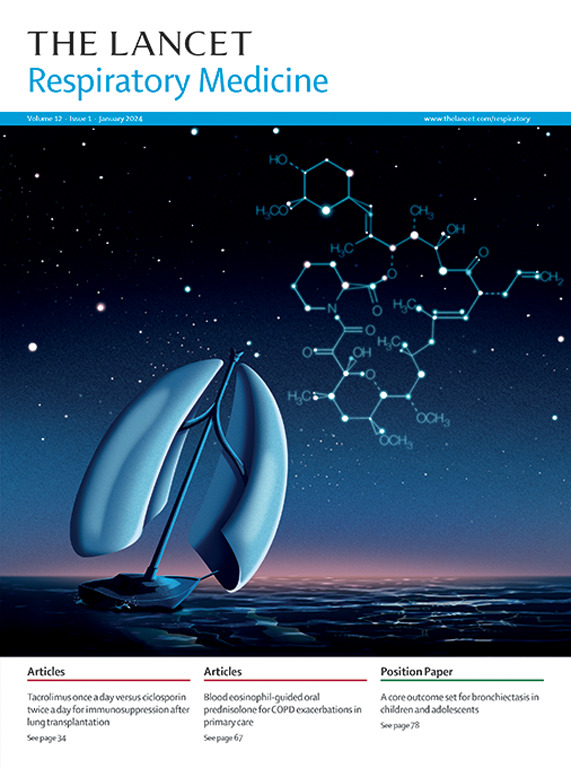在儿科急诊和ICU环境中,呼吸暂停期间鼻腔高流量氧气对低氧血症和插管成功的有效性:一项随机、对照、开放标签试验
IF 38.7
1区 医学
Q1 CRITICAL CARE MEDICINE
引用次数: 0
摘要
背景:在儿科急诊插管中使用鼻高流量(NHF)氧进行呼吸暂停氧合并没有被普遍采用。尽管先前的研究表明了潜在的益处,但目前尚不清楚NHF是否能提高儿童首次插管成功且无氧饱和度降低的可能性。我们的目的是研究在儿科急诊插管时提供NHF氧是否可以改善插管结果。方法我们在澳大利亚、新西兰和瑞士的10家医院进行了一项随机、对照、开放标签试验(包括4个急诊科、10个儿科重症监护病房和1个非产科新生儿重症监护病房)。16岁以下接受紧急气管插管的儿童符合纳入条件。参与者被随机分配(1:1)接受NHF呼吸性氧合或插管期间的标准护理。主要结局是低氧血症事件的发生(定义为血氧饱和度[SpO2]≤90%)和在修改意向治疗人群中首次插管成功且无去饱和(所有获得前瞻性或回顾性同意的参与者插管并记录主要结局)。该试验已在澳大利亚新西兰临床试验登记处注册(ACTRN12617000147381),现已完成。在2017年5月9日至2022年10月22日期间,969名儿童的1069次插管被随机分配到NHF组(535次插管)或标准护理组(534次插管)。初步分析包括860名儿童的950例插管,其中476例插管在NHF组,474例插管在标准护理组。在NHF组,476例插管中有61例(12.8%)发生低氧血症事件,而标准护理组474例中有77例(16.2%)发生低氧血症事件(调整优势比[aOR] 0.74;97·5% ci 0.46 - 1.18;p = 0·15)。NHF组476例插管中有300例(63.3%)插管成功,标准护理组474例插管中有280例(59.1%)插管成功(aOR 1.13;97·5% ci 0.79 - 1.62;p = 0·43)。在905例插管的按方案分析中,与标准护理(461例77例[16.7%])相比,NHF降低了低氧血症的发生率(444例48例[10.8%]);aOR 0·59;97·5% ci 0.36 - 0.97;p = 0·017)。在本分析中,NHF组444例插管中首次插管成功284例(64.0%),而标准护理组461例插管中首次插管成功268例(58.1%)(aOR 1.22;97·5% ci 0.87 - 1.71;p = 0·19)。解释:在儿童紧急插管期间使用NHF并没有导致低氧血症事件的减少或第一次插管成功率的增加。然而,在按方案分析中,低氧血症事件较少,但在首次尝试时无低氧血症的插管成功方面没有差异。急诊插管过程中应用NHF的障碍以及在生理损害之前放弃插管尝试的原因应进一步调查,为未来的研究提供信息,并为插管指南和临床实践提供建议。资助:thrasher研究基金(美国)、国家卫生和医学研究委员会(澳大利亚)和急诊医学基金会(澳大利亚)。本文章由计算机程序翻译,如有差异,请以英文原文为准。
Effectiveness of nasal high-flow oxygen during apnoea on hypoxaemia and intubation success in paediatric emergency and ICU settings: a randomised, controlled, open-label trial
Background
The use of nasal high-flow (NHF) oxygen for apnoeic oxygenation during emergency paediatric intubation is not universally adopted. Although previous studies suggest potential benefits, it remains unclear whether NHF enhances the likelihood of achieving successful first-attempt intubation without oxygen desaturation in children. We aimed to investigate whether the provision of NHF oxygen during paediatric emergency intubation can improve intubation outcomes.Methods
We conducted a randomised, controlled, open-label trial at ten hospitals in Australia, New Zealand, and Switzerland (four emergency departments, ten paediatric intensive care units, and one non-maternity neonatal intensive care unit were included). Children younger than 16 years undergoing emergency endotracheal intubation were eligible for inclusion. Participants were randomly assigned (1:1) to receive either NHF apnoeic oxygenation or standard care during intubation. The primary outcomes were the occurrence of hypoxaemic events (defined as oxygen saturation [SpO2] ≤90%) and successful intubation on the first attempt without desaturation in the modified intention-to-treat population (all intubations in participants for whom prospective or retrospective consent was given and a primary outcome was recorded). This trial is registered with the Australian New Zealand Clinical Trials Registry (ACTRN12617000147381) and is now completed.Findings
Between May 9, 2017, and Oct 22, 2022, 1069 intubations in 969 children were randomly assigned to the NHF group (535 intubations) or standard care group (534 intubations). The primary analysis comprised 950 intubations in 860 children, with 476 intubations in the NHF group and 474 in the standard care group. In the NHF group, hypoxaemic events occurred in 61 (12·8%) of 476 intubations, compared with 77 (16·2%) of 474 in the standard care group (adjusted odds ratio [aOR] 0·74; 97·5% CI 0·46–1·18; p=0·15). Successful intubation was achieved at the first attempt in 300 (63·0%) of 476 intubations in the NHF group and 280 (59·1%) of 474 intubations in the standard care group (aOR 1·13; 97·5% CI 0·79–1·62; p=0·43). In the per-protocol analysis of 905 intubations, NHF reduced the rate of hypoxaemia (48 [10·8%] of 444) compared with standard care (77 [16·7%] of 461; aOR 0·59; 97·5% CI 0·36–0·97; p=0·017). In this analysis, first-attempt successful intubation was achieved in 284 (64·0%) of 444 intubations in the NHF group versus 268 (58·1%) of 461 intubations in the standard care group (aOR 1·22; 97·5% CI 0·87–1·71; p=0·19).Interpretation
The use of NHF during emergency intubation in children did not result in a reduction in hypoxaemic events or an increase in the frequency of successful intubation on the first attempt. However, in the per-protocol analysis, there were fewer hypoxaemic events but no difference in successful intubation without hypoxaemia on first attempt. Barriers to the application of NHF during emergency intubation and the reasons for abandoning intubation attempts before physiological compromise should be further investigated to inform future research and recommendations for intubation guidelines and clinical practice.Funding
Thrasher Research Fund (USA), National Health and Medical Research Council (Australia), and the Emergency Medicine Foundation (Australia).求助全文
通过发布文献求助,成功后即可免费获取论文全文。
去求助
来源期刊

Lancet Respiratory Medicine
RESPIRATORY SYSTEM-RESPIRATORY SYSTEM
CiteScore
87.10
自引率
0.70%
发文量
572
期刊介绍:
The Lancet Respiratory Medicine is a renowned journal specializing in respiratory medicine and critical care. Our publication features original research that aims to advocate for change or shed light on clinical practices in the field. Additionally, we provide informative reviews on various topics related to respiratory medicine and critical care, ensuring a comprehensive coverage of the subject.
The journal covers a wide range of topics including but not limited to asthma, acute respiratory distress syndrome (ARDS), chronic obstructive pulmonary disease (COPD), tobacco control, intensive care medicine, lung cancer, cystic fibrosis, pneumonia, sarcoidosis, sepsis, mesothelioma, sleep medicine, thoracic and reconstructive surgery, tuberculosis, palliative medicine, influenza, pulmonary hypertension, pulmonary vascular disease, and respiratory infections. By encompassing such a broad spectrum of subjects, we strive to address the diverse needs and interests of our readership.
 求助内容:
求助内容: 应助结果提醒方式:
应助结果提醒方式:


